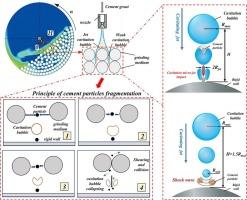Synergistic cavitation-milling for cement groutability enhancement: Particle fragmentation mechanisms and parameter optimization
IF 4.6
2区 工程技术
Q2 ENGINEERING, CHEMICAL
引用次数: 0
Abstract
The limited groutability of conventional cement grouts in narrow fractures and micropore networks remains a major challenge for effective seepage control in grouting engineering. This study proposes a novel cavitation-milling synergy processing methodology (CMSP) to enhance cement groutability through particle fragmentation. By integrating theoretical analysis, computational fluid dynamics (CFD) simulations, and experimental validation, the cavitation-driven mechanisms of particle fragmentation and optimal parameters were systematically investigated. Theoretical analysis revealed that the critical conditions for cavitation-driven fragmentation become more stringent with decreasing particle size and water-cement (W/C) ratio, requiring higher wall-impact velocities, reduced effective dimensionless distances, and smaller critical maximum cavitation bubble radius. Numerical simulations demonstrated that cavitation intensity is positively correlated with inlet pressure (Pin) and W/C ratio, with an optimal jet stand-off distance (D = 15 mm) identified for maximizing the cavitation effect. Experimental results confirmed that the CMSP system effectively suppresses cement particle agglomeration and enhances size reduction efficiency, achieving remarkable comminution performance under optimal condition: D90 < 30 μm, D50 < 10 μm, and nano-scale particle fraction (<1 μm) increased to 8.72 % after 60 min treatment. Parametric analysis indicated that Pin is the dominant control factor, followed by W/C ratio, with optimal fragmentation efficiency achieved at a grinding media filling rate (FR) of 20 %. This research provides fundamental insights into cavitation-driven cement fragmentation mechanisms and establishes practical guidelines for enhancing cement groutability in engineering applications through CMSP.

提高水泥可注浆性的协同空化磨粉:颗粒破碎机制和参数优化
常规水泥浆液在窄缝微孔网络中的可注浆性有限,是灌浆工程中有效防渗的主要挑战。本研究提出了一种新的空化-磨粉协同处理方法(CMSP),通过颗粒破碎来提高水泥的可注浆性。通过理论分析、计算流体动力学(CFD)模拟和实验验证相结合,系统地研究了空化驱动颗粒破碎的机理和最佳参数。理论分析表明,随着粒径和水灰比的减小,空化破碎的临界条件变得更加严格,需要更高的冲壁速度、更小的有效无量纲距离和更小的临界最大空化泡半径。数值模拟表明,空化强度与进口压力(Pin)和W/C比呈正相关,并确定了最佳射流间隔距离(D = 15 mm)以最大化空化效果。实验结果证实,CMSP体系有效抑制了水泥颗粒团聚,提高了水泥颗粒的减粒度效率,在D90 <; 30 μm、D50 <; 10 μm的最佳条件下取得了显著的粉碎性能,处理60 min后,纳米级颗粒分数(<1 μm)提高到8.72%。参数分析表明,Pin是主要控制因素,其次是W/C比,当磨矿介质充填率为20%时,破碎效率最佳。该研究为空化驱动的水泥破碎机制提供了基本见解,并为通过CMSP提高水泥在工程应用中的可注浆性建立了实用指南。
本文章由计算机程序翻译,如有差异,请以英文原文为准。
求助全文
约1分钟内获得全文
求助全文
来源期刊

Powder Technology
工程技术-工程:化工
CiteScore
9.90
自引率
15.40%
发文量
1047
审稿时长
46 days
期刊介绍:
Powder Technology is an International Journal on the Science and Technology of Wet and Dry Particulate Systems. Powder Technology publishes papers on all aspects of the formation of particles and their characterisation and on the study of systems containing particulate solids. No limitation is imposed on the size of the particles, which may range from nanometre scale, as in pigments or aerosols, to that of mined or quarried materials. The following list of topics is not intended to be comprehensive, but rather to indicate typical subjects which fall within the scope of the journal's interests:
Formation and synthesis of particles by precipitation and other methods.
Modification of particles by agglomeration, coating, comminution and attrition.
Characterisation of the size, shape, surface area, pore structure and strength of particles and agglomerates (including the origins and effects of inter particle forces).
Packing, failure, flow and permeability of assemblies of particles.
Particle-particle interactions and suspension rheology.
Handling and processing operations such as slurry flow, fluidization, pneumatic conveying.
Interactions between particles and their environment, including delivery of particulate products to the body.
Applications of particle technology in production of pharmaceuticals, chemicals, foods, pigments, structural, and functional materials and in environmental and energy related matters.
For materials-oriented contributions we are looking for articles revealing the effect of particle/powder characteristics (size, morphology and composition, in that order) on material performance or functionality and, ideally, comparison to any industrial standard.
 求助内容:
求助内容: 应助结果提醒方式:
应助结果提醒方式:


